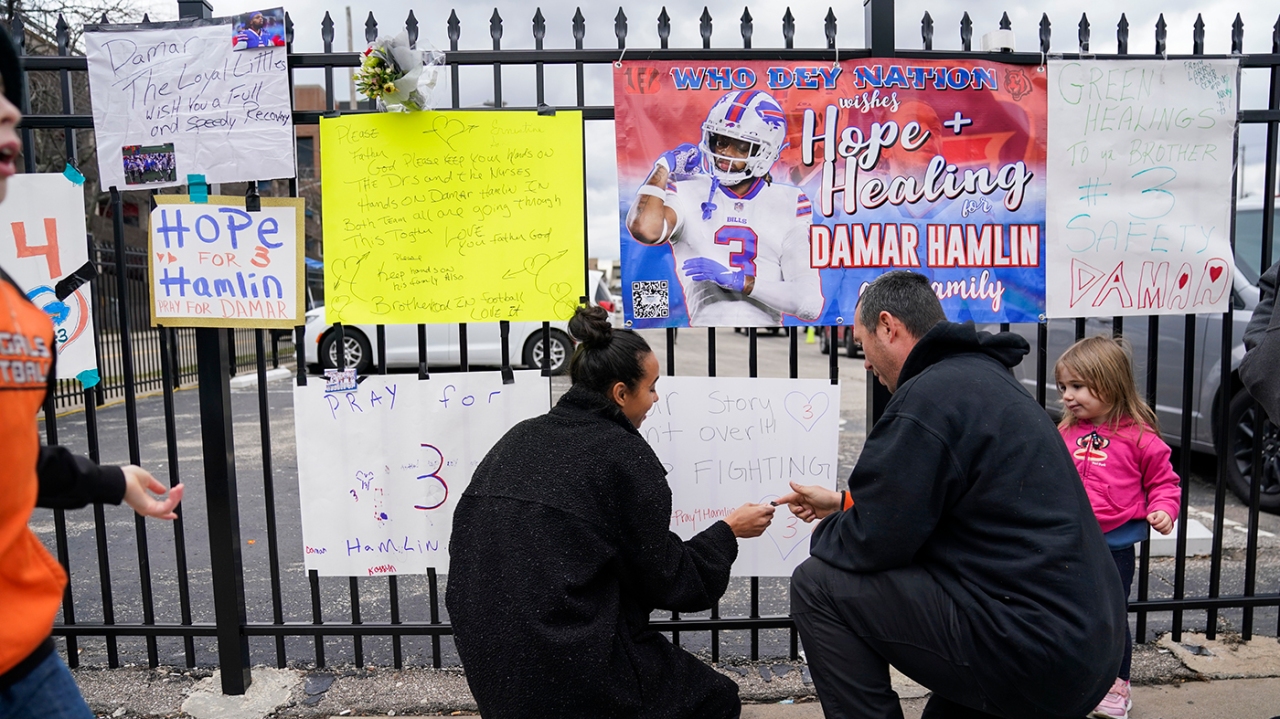Damar Hamlin’s tragic gridiron collapse underscores a longstanding societal dilemma over a game that, however deeply engrained in American culture, might just be too dangerous to play.
Participation in tackle football among children has been slipping for years amid mounting safety concerns. The signal moment in that decline was probably the release of a 2017 study that examined the brains of 111 deceased NFL players and found a degenerative disease in all but one. Together with a landmark 2013 book and a 2015 Will Smith film, the Boston study seeded public awareness of chronic traumatic encephalopathy (CTE), inspired reforms and sent thousands of families searching for safer sports.
Head injuries may get the most ink, but football poses a risk to many parts of the human body, including the heart. Hamlin, a 24-year-old safety on the Buffalo Bills, suffered cardiac arrest and collapsed on the field Monday night after tackling an opponent. Doctors restarted his heart on national television.
Fortunately, Hamlin was sufficiently recovered by week’s end to FaceTime with his teammates.
Even so, his high-profile injury has reignited debate over the fundamental safety of a game that, even after a century of progress in protective equipment and medical protocols, still requires its participants to crash into each other.
More than 1.5 million children play tackle football. Surveys suggest they and their families know the risks, as well as the reforms, and believe the game can be played safely. Colliding heads and concussions are becoming less common.
“I think it’s frankly as safe as it’s ever been for a kid to play,” said Bruce Howard, a spokesman for the National Federation of State High School Associations, a rulemaking body for high-school sports.
But the helmeted ranks are thinning. Participation in high-school football declined from 1.1 million students in 2008 to 973,000 in 2022, Howard said. Among children ages 6 to 12, tackle football participation has dropped by nearly 40 percent in the same span, according to the Aspen Institute.
Lawmakers in several states have even proposed measures to ban tackle football for younger children. None of the initiatives has passed.
“Football’s not going away, and I don’t think that it should,” said Mariah Warner, a doctoral candidate and football researcher at the Ohio State University, and a lifelong New England Patriots fan. “I want to watch quality, safe football. But I don’t think that means 7-year-olds should be tackling each other with metal helmets on.”
The societal retreat from tackle football in the preteen and tween years arises from two brain research findings.
One is that the risk of CTE rises with more years of play. A child who starts tackle football in elementary school and plays through college faces far more risk of cognitive decline, researchers say, than someone who starts in high school.
The second is that a child’s brain is still growing and more vulnerable to injury.
“What occurred was that parents looked at the risk to their children, and they recognized that there was a risk to the developing brain, and that was something that they had to take seriously,” said Gregory O’Shanick, medical director of the Center for Neurorehabilitation Services in Richmond, Va., and board member of the Brain Injury Association of America.
“When you look at the No. 1 cause of concussions, in terms of sports, it is, in fact, football,” he said.
A Centers for Disease Control and Prevention page advises, “We all play a role in protecting youth from concussion.” The federal agency cites a study that found children who play tackle football sustain 15 times more “head impacts” than athletes in flag football, a tackle-free variant.
A competing page, uploaded by the NFL, offers talking points for coaches looking to rebuild flagging programs. “You might get some questions — here’s how you can answer them,” the site says, listing safety enhancements and urging coaches, with just a hint of defiance, to “help parents see for themselves.”
In the 6-12 demographic, tackle football trails several other team sports in participation, including baseball, basketball, soccer, tennis, golf and volleyball.
But football remains America’s national sport, in terms of popularity and television viewers. And it retains its dominance in high schools, even after the modest decline of the past decade.
Given the sport’s public relations issues, researchers have grown curious about the sensibilities of the million-plus families that still support the sport.
Warner and her Ohio State colleagues surveyed nearly 4,000 Americans and found them almost evenly divided on whether tackle football is appropriate for children.
Football supporters tend to be male, conservative, racially diverse, patriotic and a bit less educated than those who think the sport ill-suited to the young.
“It’s not just your gender, just your race or just your class, or whether you played football, but a lot of those things in combination with each other,” she said. “Football has been thought of as this sport that turns boys into men.”
A survey of high school athletes by researchers at Grand View University in Iowa found that students who quit football worried more about earning money and managing time than avoiding concussions.
“The kids who have chosen to play have taken on that risk and understand there are potential harms, but they’re willing to play anyway,” said Scott Bull, an associate professor of sport management at Grand View.
Indiana University researchers surveyed public attitudes toward juvenile football and found well-reasoned arguments on both sides.
The Indiana survey asked respondents if they would let a teenage boy play tackle football. Those who said yes tended to know a lot about the game and its safety protocols, said Kyle Kercher, an assistant professor of sport management in the university’s School of Public Health.
Those who said no tended to be well-versed on the potential for brain injury and to think the sport is implicitly unsafe.
Like his colleagues in Ohio and Iowa, Kercher is a football fan. He played in high school and college. He sustained two concussions. He awoke from one at a stadium in Oregon, thinking he was in Montana.
To help the sport, Kercher has conducted groundbreaking research on how coaches can conduct meaningful practices without injuring brains.
Kercher’s findings sound obvious. Players are much less likely to butt heads when they run drills without physical contact, and when they collide with a bag rather than a body. Coaches can run “control” drills, which halt at the moment of contact, and “thud” drills, which stop in mid-tackle.
“It wasn’t that long ago that I was in high school, and there were no limits on how much we hit each other,” he said. Today, coaches are learning to limit tackles outside of games. At game time, players are instructed not to “lead with their head,” Kercher said.
When Kercher was a graduate student, a colleague told him, “Nobody should be allowed to play football,” thinking he would agree. He did not.
“My whole approach to this is, I feel it is so deeply, culturally ingrained in American society, I don’t see it going away,” he said. “And so, I want to make it as safe as possible.”
Author Profile
- "Center" Bias Rating
- The Hill is an American newspaper and digital media company based in Washington, D.C. that was founded in 1994. Focusing on politics, policy, business and international relations, The Hill's coverage includes the U.S. Congress, the presidency and executive branch, and election campaigns.
Latest entries
 HeadlinesOctober 22, 2023'Calculated misery': Here's why airlines want you to be uncomfortable
HeadlinesOctober 22, 2023'Calculated misery': Here's why airlines want you to be uncomfortable HeadlinesOctober 19, 2023Pressley, Booker Reintroduce MOMMIES Act to address maternal health disparities
HeadlinesOctober 19, 2023Pressley, Booker Reintroduce MOMMIES Act to address maternal health disparities HeadlinesJune 14, 2023Jill Biden warns against Trump: 'We know what’s in store if these MAGA Republicans win'
HeadlinesJune 14, 2023Jill Biden warns against Trump: 'We know what’s in store if these MAGA Republicans win' HeadlinesJune 13, 202311 dead in Russian missile attack on Zelensky's hometown
HeadlinesJune 13, 202311 dead in Russian missile attack on Zelensky's hometown

